The Ming class: Last Chinese SSG
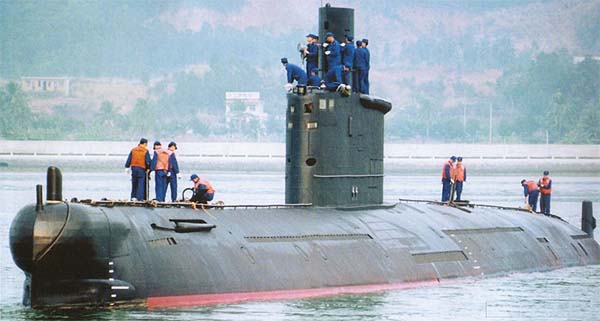
Type 035B, NATO Ming class, returning from a mission – src histamar.com.ar source The 035B was the last version, an hybridation with the next 039 Song class conventional attack submarines.
It could be summarized as the “Chinese Foxtrot”, a late, large mass-production serie of a conventional attack submarine. By “conventional” it is heard, non nuclear-powered. The linchpin of the program has been, just like Soviet contemporary SSGs, the reduction of noise level. The Ming class subs formed in the late cold war the bulk of Chinese submarine force. They were gradually retired up to 2019, but still nine Type 035G and 5 Type 035B seems to be active, so 14 total, more than half of the total delivered.
No doubt they will end in a reserve status soon, when replaced either by SNAs or updated, stealthy SSGs of the new generation. They were quite different than the “Romeo-class” Type 033 of which about 84 were delivered until 1984.
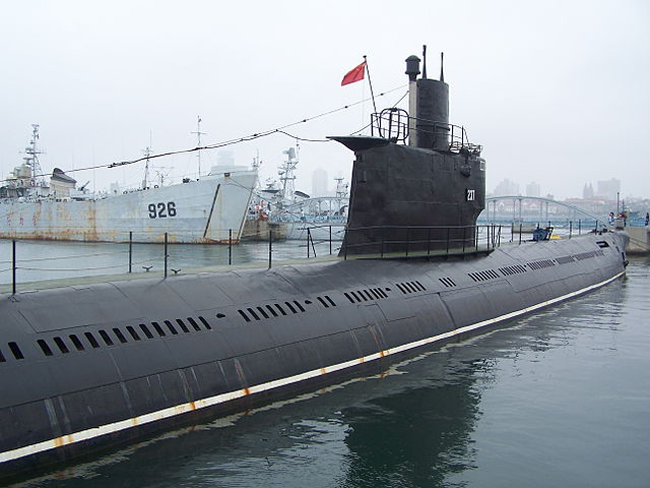
The rear section of the Type 033. The most striking different is a more “bulky” top section and stern tail for the 035.
Development history of the Type 035
Due to the glaciation of relations with USSR, the 1950 Sino-Soviet Treaty of Friendship, Alliance and Mutual Assistance was long forgotten and there was no choice but develop a new generation of indigenous submarine base on the Type 033 Romeo technology in the 1960s.
Chinese authorities soon charged 701 Institute, also known as the Wuhan Ship Development and Design Institute to start working on an improved version of the Romeo. The Type 035 was still in some ways, close to the 033, and the first two boats (Type 035 proper) were eventually delivered in 1974, after a record-time two years in development which ended in 1969 and triggered two orders.
Indeed in October 1969, both Wuchang Shipyard and Jiangnan Shipyard started construction of a prototype, which were called the Type 035. The new submarines emerged whereas the Type 033 was still evolving, but this was before China operated a rapprochement to the west, allowing to radically upgrade its ageing submarine designs.
Hull of the Type 035


Visual comparison of both models.
The hull was 76 m (249 ft) long, for 7.6 m (25 ft) wide, and 5.1 m (17 ft) in draft and 7.6 m (25 ft) in depth as compared to 76.6 m (251 ft 3 in) long for the 033, a beam of 6.7 m (22 ft) and a draught of 5.2 m (17 ft 1 in), for a displacement of 1,475 tons surfaced and 1,830 tons submerged. So the length seemed unchanged, but the hull was much beamier and thus, roomier, whereas the draft seemed slightly lower, but these figures are to take with caution.
External features also diverged considerably between the two: The prow’s fixed, passive sonar array was integrated into the nose bulge, some changes in the completely reworked rear tail and rudder part (which still kpt the horizontal tail, included propellers hubs), the underbelly cut (the hull was straight on the previous 033), allowing to save some weight, the vertical rudder, which did not existed on the previous class, still much influenced in design by the Type XXI U-Boats, the flat upper hull (no raised forward part as on the 033) which as also a cost-saving measure, simplifying production, and the kiosk shape, longer, with a lower bulge, and a different conning tower and array of periscopes and sensors.
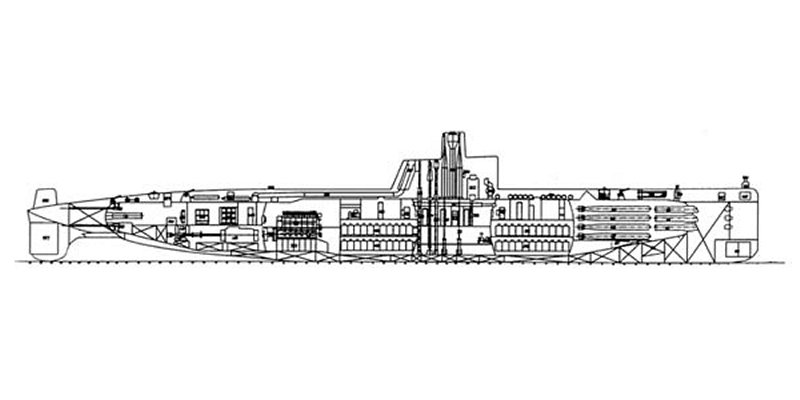
Blueprint – cutaway of the class. Src unknown.
All in all, apart dimensions, the 035 (named “Ming” by NATO as soon as spotted) was a totally different beast, and truly the first Chinese indigenous submarine, made in total isolation with some ingenuity and original solutions. Nothing is known however of any noise-reduction measures other than reworking the hull shape. Like other domestic classes, it was made in gradual steps, with a first couple of boats, then a prototype for a more advanced serie, and then a large scale upgraded serie in the late 1980s.
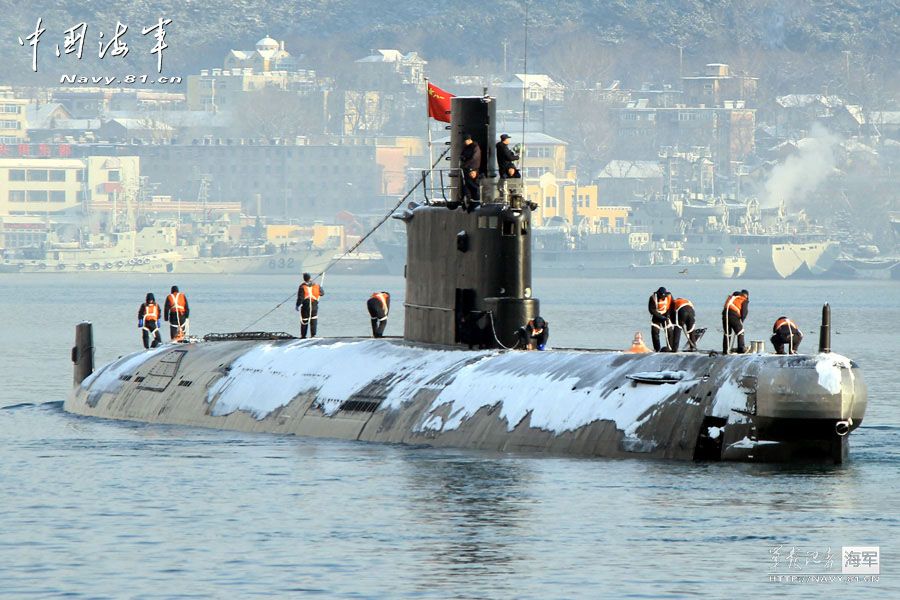
Ming class submarine in winter – src Navy81.cn
Propulsion of the Type 035
While the Chinese 033 innovated by making a noise reduction of 20 dB and introducing a more capable Chinese Type 105 sonar, and later a H/SQ2-262A model, there is little information about the noise level reduction on the Type 035.
The Romeos were given two diesels rated for 2.94 MW (4000 shp), coupled with two electric drives for the propellers shafts. This was able to propel the boats to 15.2 knots surfaced and 13 knots submerged. The Type 035 was improved in that area, with a couple of type E390ZC-1 diesel engines rated for 5,200 hp (3,900 kW) total, making them capable of 18 knots (33 km/h) submerged (From the Type 035A onwards). This was was quite an improvement, allowing to get out of the path of an USN Frigate of the pre-OH perry class. It should be added that the Ming had a reinforced hull and is claimed able to pass the 300 m (980 ft) depth threshold. The first Type 035 of 1974 however had a single shaft, whereas the following series had two.
Range of the Type 033 was 14,484km (9,000 miles) at 9 knots, but it is unknown for the Ming class.
A third boat was completed with two shafts shortly after the first two (ES5D), pennant number 342, which proved unsatisfactory during trials, so much so that the 701 institute was asked to perform a major redesign. The problem was solved and the boat gained an increase in submerged top speed, to 18.5 knots (33.9 km/h; 21.1 mph).
Armament of the Type 035
The Romeos were given eight 533mm (21in) torpedo tubes, six in the bow and two in the stern, with fourteen anti ship or anti submarine torpedoes or 28 mines. With the 033G, the Chinese introduced new acoustic homing torpedoes served by analog computers and with the single G1 ws modified to carry six YJ-1 (CSS-N-4). On the 035 it was unchanged, at least for the first series. The basic 035 or ES5C, pennant numbers 232 and 233, had these original torpedo tubes. From the ES5C onwards, an updated fire control system to launch acoustic homing torpedoes was installed. This was to be the export version, but none was ever exported. Instead, the system was likely passed onto the design of the Type 035A and to upgraded the Type 035. See the notes below.
Production & Variants
Modifications were completed in 1980 and the 342 entered service after two years of furter trials and modifications in 1982. Since it was a clear evolution, the boat was then re-designated Type 035A and three more approved. The 035A also motivated Chinese authorities to order to stop the production of the 033 and swap to the new type. However this has to last until 1987 and then three more 035A, 352, 353 and 354, were ordered.
The first serie was given:
-Type 921-A Golf Ball ESM RWR Radar Warning Receiver (222.2 km range)
-Pike Jaw hull passive Attack Sonar (Range 3.7 km)
-Trout Cheek [Derived from the Soviet MG-10M Feniks-M shared by the November, Romeo and Foxtrot) Active/Passive hull sonar, range 18.5 km.
-Snoop Plate Surface Search Short-Range radar (46.3 km), also soviet-derived (Flag system)
-Acoustic Intercept active warning sonar [Based on the MG-23 Svet-M] (27.8 km)
-They were also equipped with a decoy system, of the 1970s generation, of the noisemaker/Bubble Screen Expendable type (1.9 km)
-They were armed with 8 tubes, 14 Yu-1 Straight Runner torpedoes (1973) range 5.6 km.
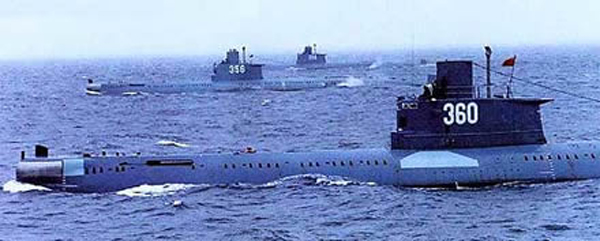
A group of three Ming-class ongoing – src. submarine matters
The ES5D was a variant of the above design also tailored for export. It had the capability to launch anti-ship missiles when submerged and was applied to the #342 first (lead boat of the 035A) then ported on the next three and used as an upgraded for the first two 035. More options will be added, often through an export proposal which was ported on older versions as an upgrade:
Type 035G submarine (1989)
The Type 035G inaugurated a new wave of modifications and development started in 1985, likely to integrate now available western electronics. The first boat was released just when the cold war was about to end, launched in 1989 and entering service in December 1990. #356, the lead boat was state certified after numerous trials in 1993, and production of the 357, 358, 359, 360, 361, 362, 363, 305, 306, 307 and 308 was sanctioned. All these had extensive anti-submarine (ASW) capabilities for the first time.
The lead ship 356 inaugurated the Yu-3 torpedo, a domestic acoustic homing torpedo capable of firing an anti-ship missile.
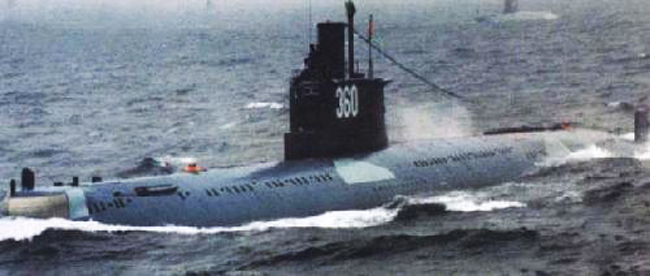
About the Chinese Yu-3 homing torpedo
The Yu-3 development started in 1969 at the Acoustic Research Institute of the Chinese Academy of Science and the 705th Institute, and the program was led by Mr. Hou Chaohuan. It was capable of hitting a target at 750 m depth when tested at the 750 Testing Range. Oceanic tests began in 1972, and the design was finalized in 1975, but it would take some more years and about 40 companies to solve other problems that erupted during trials. In the end, the Yu-3 development was finalized by the Yunnan 6th Machinery Bureau, but the project dragged on until December 1977 and went a long way until 1983. Production started in March 1984 and the Han class were the first to receive it, firing some in 1988, and the modified Ming class was the second one to adopt it.
The YU-3 was a 7.8 meter, 21-in torpedo, weighting 1.34 ton with a warhead of 205 kg, and guided with an active/passive acoustic homing device, and propelled by and electrical, silver-zinc battery. Operational range was 13 km at 35 knots, and practical depth lower than 400 metre. A slightly less capable ET32 torpedo was also developed for export.
In addition, these boats were fitted with a French sonar DUUX-5 which was soon reverse-engineered and replaced by a Chinese-built version were used on later units. The Type 035G was further developed into the ES5E for export, but no order came. The latter had the ability to launch wire-guided torpedoes and this came as an upgrade for the G type and earlier versions and it did not applied to a particular submarine, but the whole G serie. It was further enhanced as the 035ET, also for export, this time with a cheaper JP-64 active sonar/Velox passive sonar from the Toti-class submarine. This version also failed to attract customers.
Type 035B Ming (2000)
The 035B was the last serie, with a first batch of four completed 2000-2003 (309, 310, 311, 312), and an additional order with the 313, which was the last of the serie. It was an hybrid between the new 039 Song-class and the Ming, integrating its new Conning tower, while a large portion of the hull was redesigned to be made more hydrodynamic, with a new coating, and a internal arrangement also copied over the Type 039 submarine. This last Ming type was was given land attack cruise missiles, launched from the same 21-in torpedo tubes. The 035B was armed with the Yu-4A 1985 torpedo and ET31, which has a 5.6 km range.
Sensors/Equipments of the Type 035B
-Type 921-A Golf Ball – ESM RWR, Radar Warning Receiver (Range: 222.2 km)
-SQG-2B [DUUX 5] Hull Sonar, Passive-Only, from the Han-class, Ranging Flank Array Search & Track (Range: 74.1 km)
-SQC-1 [DSUV 2H + DUUA 2D] – (DSUV 22 from Han class) Active/Passive Hull Sonar (Range: 74.1 km)
-Snoop Tray 2 [MRK-50E Kaskad] Export Radar (ES5F) Surface Search and Short-Range 37 km.
-DUUX 5 Fenelon [TSM 2255] SQB-2 passive Hull Sonar, Ranging Flank Array Search & Track (Range 74.1 km)
-Generic Acoustic Intercept SQB-2, Active Sonar Warning system, range 66.7 km.
-Generic Acoustic Decoy type Noisemaker/Bubble Screen, Expendable with 1.9 km range.
The ES5F was an export version of the 035B with integrated sonar system with separated active and passive ranging but also flank sonar into one single unit.
https://youtu.be/AaBouv4u8j4
Some footage (CCTV) of the Ming-class and crew.
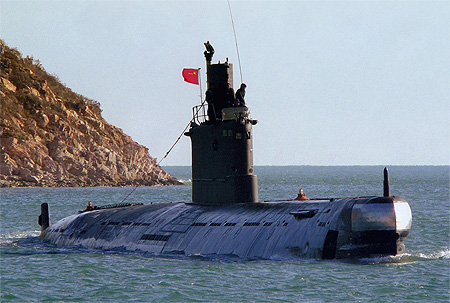
Type 035 – src thempirestwilight.fandom.com
Bangladeshi Mings
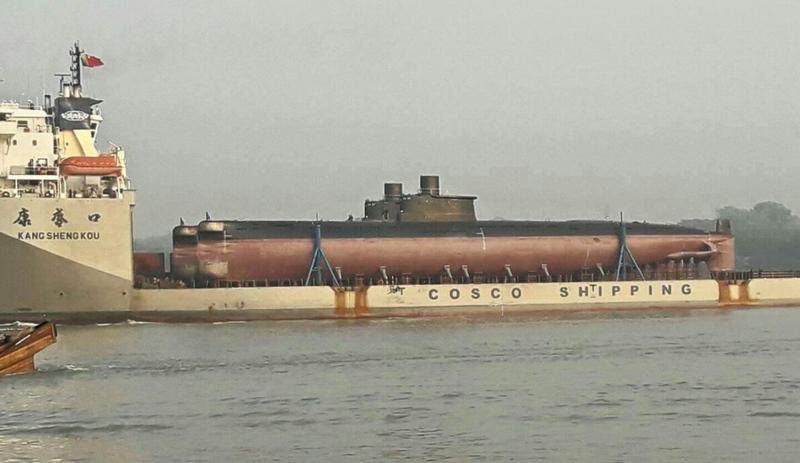
Type 035G delivered to Bangladesh
The Bangladesh government was already a customer of Chinese Armoured Fighting vehicles. Two submarines ordered while in service of the Type 035G in 2013. Bangladesh defence ministry’s inter-services public relations directorate (ISPRD) confirmed with IHS Jane’s on 15 November 2016.
The contract, worth $203 million (BTD16 billion) included a refit in China to be tailored to the Bangladeshi needs and they were to be delivered at Dalian on 14 November 2016 to Admiral Nizamuddin Ahmed. The were the former #356 and 357. These became the very first Bangladesh submarines, named BNS Nabajatra (S 161) and BNS Joyjatra (S 162) respectively, commissioned on 12 March 2017. The press went in detail on these, carrying Yu-4 anti-surface heavyweight torpedo and up to 32 naval mines.
Their electronic suite comprised a H/SQ2-262C active sonar (relativel similar to Pike Jaw MG-100, derived from the French French DUUX-5 passive sonar) and ES5F integrated sonar system. MRK-50 Topol (Snoop Tray) surface search radar is also used, as well as a Magnavox satellite navigation system and Type 921A for electronics warfare. But in overall capability they are quite inferior to the 035B.
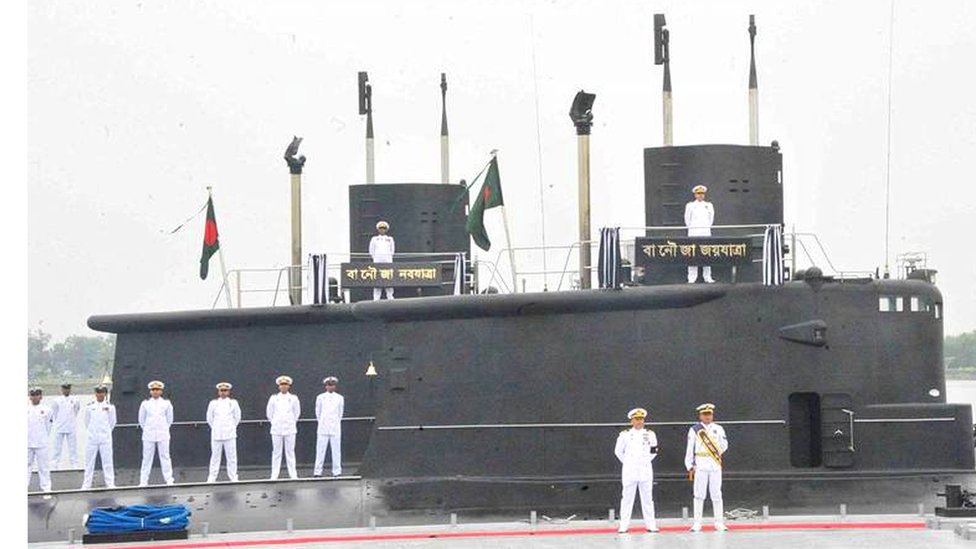
Bangadesh Ming class BNS Nabajatra (S 161) and Joyjatra (S 162) in the background – Press release (unknown).
The Type 035 Ming in service
All boats were active until the end of the cold war, and 15 were registered active on the Northern fleet. Today, it is perhaps 20 with the latest 2000s 035B acquisitions. They are completed by the four Han class SSNs. There is of course little to no information available about their deployments, and possible incidents. But we do have information about the only know which was lost at sea: #361. The initial serie of 1973 has been retired (the two Type 035s) in the 1990s, and followed later by the four Type 035A. Nowadays only the Type 035G and hybrid 035B stays active, probably for the latter, until the 2030s, unless they are replaced faster by the upcoming generation of super-stealthy Chinese SSGs. Indeed the basic design will be nearly 60 years old in 2020 !
The case of 361 “great wall”
The #361 was one of the twelve 035G Ming class (ES5E) in service, relatively recent in the Chinese arsenal. She was was part of the 12th Brigade, North Sea Fleet of the PLAN, based at Lüshunkou (Liaoning Province). According to CNN, intensive training and exercises in the east were taking place to enforce a large scale “sea denial” towards the U.S. Pacific fleet. According to Xinhua, the loss of the submarine and entire crew off the Changshan Islands in the Yellow Sea was due to carbon poisoning when the diesel engine failed to enter in a close loop properly and used up all the oxygen when submerged on April 16, 2003.
The reason why the crew was not able to surface in emergency is still unclear. Among the victims were 13 trainee cadets from the Chinese naval academy. The submarine was localized, salvaged and towed to port at the time for the enquiry when it happened. It has been deriving for ten days and was discovered by a Chinese fishing trawler.
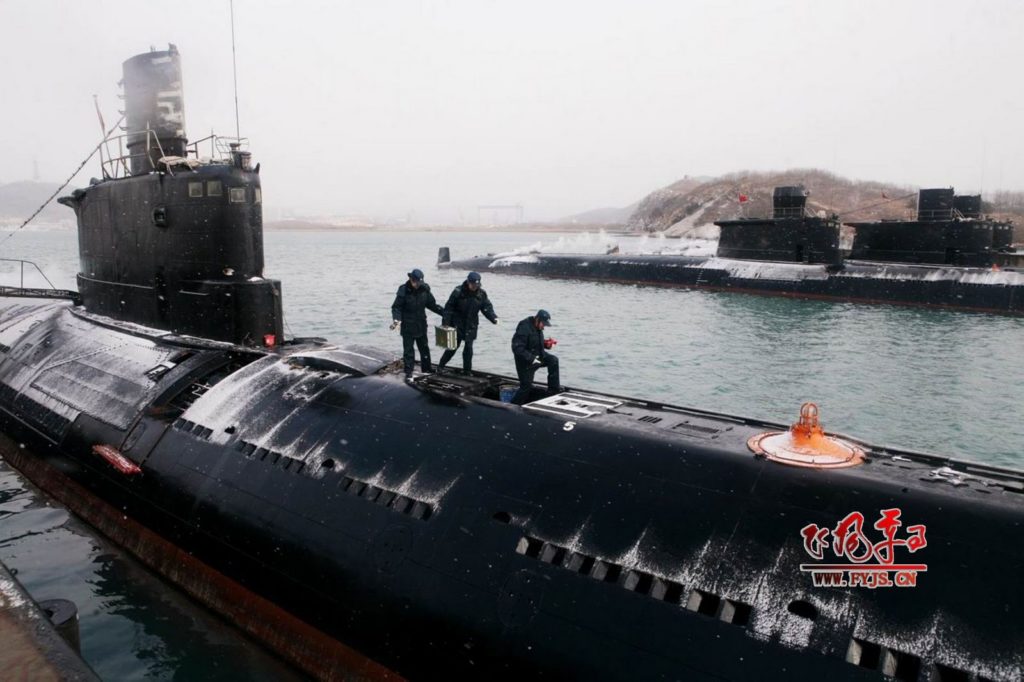
A closeup of a Ming class at anchor, with female crew – src fyjs.cn (googleusercontent) on defence.pk
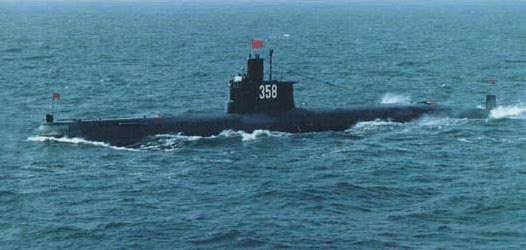
Type 035 at sea – src globalsecurity.org
Read More/Src
https://web.archive.org/web/20060614012240/http://www.sinodefence.com/navy/sub/035.asp
https://web.archive.org/web/20060709084621/http://www.china-defense.com/naval/wuhan351/wuhan351.html
https://www.janes.com/article/31886/bangladesh-reported-to-have-signed-submarine-deal-with-china
Modeller’s Corner: Hobby Boss Type 035 Ming
http://cmano-db.com/submarine/China/
http://gentleseas.blogspot.com/2013/12/china-selling-two-type-035-ming-class.html
Ming class 3D on turbosquid.com


 Latest Facebook Entry -
Latest Facebook Entry -  X(Tweeter) Naval Encyclopedia's deck archive
X(Tweeter) Naval Encyclopedia's deck archive Instagram (@navalencyc)
Instagram (@navalencyc)





 Austrian Navy
Austrian Navy French Navy
French Navy Royal Navy
Royal Navy Armada Espanola
Armada Espanola K.u.K. Kriegsmarine
K.u.K. Kriegsmarine Dansk Marine
Dansk Marine Nautiko Hellenon
Nautiko Hellenon Koninklije Marine 1870
Koninklije Marine 1870 Marinha do Brasil
Marinha do Brasil Osmanlı Donanması
Osmanlı Donanması Marina Do Peru
Marina Do Peru Marinha do Portugal
Marinha do Portugal Regia Marina 1870
Regia Marina 1870 Nihhon Kaigun 1870
Nihhon Kaigun 1870 Preußische Marine 1870
Preußische Marine 1870 Russkiy Flot 1870
Russkiy Flot 1870 Svenska marinen
Svenska marinen Søværnet
Søværnet Union Navy
Union Navy Confederate Navy
Confederate Navy Armada de Argentina
Armada de Argentina Imperial Chinese Navy
Imperial Chinese Navy Marinha do Portugal
Marinha do Portugal Mexico
Mexico Kaiserliche Marine
Kaiserliche Marine 1898 US Navy
1898 US Navy Russkiy Flot
Russkiy Flot French Naval Aviation
French Naval Aviation Russian Naval Aviation
Russian Naval Aviation Sovietskiy Flot
Sovietskiy Flot Royal Canadian Navy
Royal Canadian Navy Royal Australian Navy
Royal Australian Navy RNZN Fleet
RNZN Fleet Chinese Navy 1937
Chinese Navy 1937 Kriegsmarine
Kriegsmarine Chilean Navy
Chilean Navy Danish Navy
Danish Navy Finnish Navy
Finnish Navy Hellenic Navy
Hellenic Navy Polish Navy
Polish Navy Romanian Navy
Romanian Navy Turkish Navy
Turkish Navy Royal Yugoslav Navy
Royal Yugoslav Navy Royal Thai Navy
Royal Thai Navy Minor Navies
Minor Navies Albania
Albania Austria
Austria Belgium
Belgium Columbia
Columbia Costa Rica
Costa Rica Cuba
Cuba Czechoslovakia
Czechoslovakia Dominican Republic
Dominican Republic Haiti
Haiti Hungary
Hungary Honduras
Honduras Estonia
Estonia Iceland
Iceland Eire
Eire Equador
Equador Iran
Iran Iraq
Iraq Latvia
Latvia Liberia
Liberia Lithuania
Lithuania Mandchukuo
Mandchukuo Morocco
Morocco Nicaragua
Nicaragua Persia
Persia San Salvador
San Salvador Sarawak
Sarawak Uruguay
Uruguay Venezuela
Venezuela Zanzibar
Zanzibar Warsaw Pact Navies
Warsaw Pact Navies Bulgaria
Bulgaria Hungary
Hungary

 Bundesmarine
Bundesmarine Dutch Navy
Dutch Navy Hellenic Navy
Hellenic Navy Marina Militare
Marina Militare Taiwanese Navy
Taiwanese Navy Chinese Navy
Chinese Navy Indian Navy
Indian Navy Indonesian Navy
Indonesian Navy JMSDF
JMSDF North Korean Navy
North Korean Navy Philippines Navy
Philippines Navy ROKN
ROKN IDF Navy
IDF Navy Royal New Zealand Navy
Royal New Zealand Navy Egyptian Navy
Egyptian Navy South African Navy
South African Navy

































 RN
RN
 Marine Nationale
Marine Nationale
 Soviet Navy
Soviet Navy
 dbodesign
dbodesign